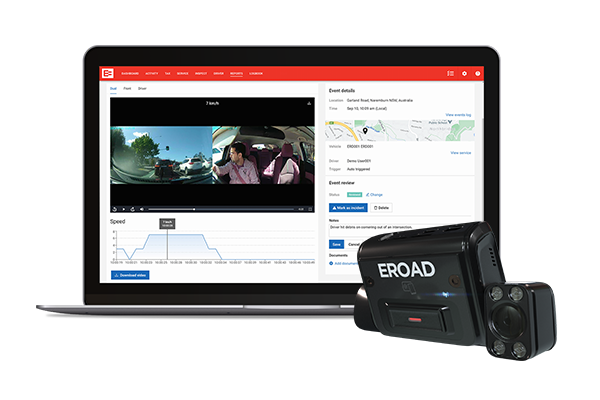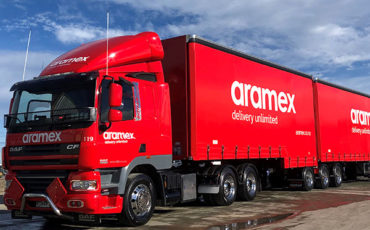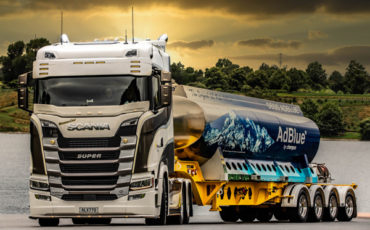Faster incident resolution – and higher video resolution as well!
Faster incident resolution – and higher video resolution as well!
McCarthy Transport uses “the best to provide the best”: They rely on the EROAD Clarity Dashcam to protect their drivers and assets.
McCarthy Transport is a logging cartage contractor in New Zealand, with hubs in Wanganui, Karioi, and Masterton. Family-owned and operated by three generations of McCarthys, they started with just three logging trucks 71 years ago and now have 136.
Operations manager Mike McCarthy oversees all parts of the business, including the workshop and engineering division where they build their own trailers. McCarthy Transport has had EROAD telematics for at least 10 years now and they’ve just done a big upgrade: Any remaining units with the first-gen Ehubo are being replaced with the Ehubo2, and all trucks are getting the EROAD Clarity dashcam.
But this isn’t McCarthy’s first foray into dashcams. Previously, they had another, more basic system: “Like the EROAD camera, it’s constantly recording,” says Mike, “but you can’t go live on it. You have an incident, you request the footage, and it downloads.”
The other thing was that the night-time picture resolution on the outward-facing camera was “very poor.” While he says their old cameras worked well enough to more or less reach the same conclusion in the event of an incident, “it would have been a lot harder to see. When we tried EROAD, it was chalk and cheese, the quality of the video.” The picture clarity they experience with the EROAD Clarity Dashcam provides valuable peace of mind.
The management portal of the old system was also “a lot clunkier” and more difficult to navigate when trying to retrieve footage. “MyEROAD is really well laid out. It’s reasonably simple and easy to find what you want. It’s a lot more user-friendly and better quality than what we had.”
McCarthy Transport uses “the best to provide the best”: They rely on the EROAD Clarity Dashcam to protect their drivers and assets.
McCarthy Transport is a logging cartage contractor in New Zealand, with hubs in Wanganui, Karioi, and Masterton. Family-owned and operated by three generations of McCarthys, they started with just three logging trucks 71 years ago and now have 136.
Operations manager Mike McCarthy oversees all parts of the business, including the workshop and engineering division where they build their own trailers. McCarthy Transport has had EROAD telematics for at least 10 years now and they’ve just done a big upgrade: Any remaining units with the first-gen Ehubo are being replaced with the Ehubo2, and all trucks are getting the EROAD Clarity dashcam.
But this isn’t McCarthy’s first foray into dashcams. Previously, they had another, more basic system: “Like the EROAD camera, it’s constantly recording,” says Mike, “but you can’t go live on it. You have an incident, you request the footage, and it downloads.”
The other thing was that the night-time picture resolution on the outward-facing camera was “very poor.” While he says their old cameras worked well enough to more or less reach the same conclusion in the event of an incident, “it would have been a lot harder to see. When we tried EROAD, it was chalk and cheese, the quality of the video.” The picture clarity they experience with the EROAD Clarity Dashcam provides valuable peace of mind.
The management portal of the old system was also “a lot clunkier” and more difficult to navigate when trying to retrieve footage. “MyEROAD is really well laid out. It’s reasonably simple and easy to find what you want. It’s a lot more user-friendly and better quality than what we had.”
Already paying off
Just three months after switching, the EROAD Clarity Dashcam came in handy: “We had an incident where a truck lost traction on a slippery road and went into a bank, and the truck ended up on its side.”
Having visited the accident site himself, Mike admits that the logical conclusion to jump to would be that the driver had been going too fast and simply lost control of the vehicle. After reviewing the dashcam footage and the vehicle’s speed, however, it was clear that the incident was simply the result of “really, really bad luck”.

“The driver wasn’t doing excessive speed; he was driving like any other professional truck driver would. He hit a slippery surface and locked up, but the dashcam just made it really clear – and you can’t argue it, really. It’s there and that’s how it was, so it just takes all of the questions away, having that footage.”
Even better, incidents can be resolved in a timely manner, providing quick relief to the people involved: “The driver’s not stressing going, Was that my mistake? or What could I have done better? It’s just all done and dusted, and you can move on.”
Because he was uninjured, the driver was actually cleared for work the very next day, meaning no downtime for himself or McCarthy Transport. “without the dashcam, that could have taken three days rather than one day.”
Insurance companies are also part of this speedy resolution. They requested the footage and were able to see exactly what happened, nullifying the need for further questions or investigation – and facilitating a faster pay-out.
Safer, more sustainable roads for everyone
So exactly why did the accident happen?
“It was a very poor road surface, so the tar seal had risen,” explains Mike. With no stones on top to provide traction, the surface was smooth and, to make matters worse, it had rained heavily the night before.
“It was a wet, wet road,” he recalls, “but a lot of guys who stopped said, ‘Yeah, that’s a dangerous piece of road. Everyone knows about that.’”

Which led Mike to wondering why no one was doing anything about it. So they sent the footage to the local council, who were actually already aware of the problem. But because of the footage, they saw just how bad it was, fast-tracked the repairs, and the road is now good as new!
Speaking of fast, the investigation itself, which might normally take a week, was cut down to just a day.
Dashcams embraced by the team
Driver adoption of dashcams was relatively smooth as well, with only about 20% questioning the need. But once they saw and understood how the camera actually works – and that audio was not being picked up – they were fine with it.
“There’s been anti-dashcam guys who have been involved in incidents, and they are now very, very pro-dashcam.” In one case, a motorcyclist, suddenly crossed the centre line and collided with the truck, resulting in a fatality – one that could not have been prevented by the driver.

While he believes the investigation would have rightfully concluded that the driver was not at fault, there would have been a lot more questions around it. Including from the driver himself.
“Being able to show the driver that was really good closure,” says Mike. “And it certainly makes my job a lot easier, too.”
Learn more about the EROAD Clarity Dashcam.













